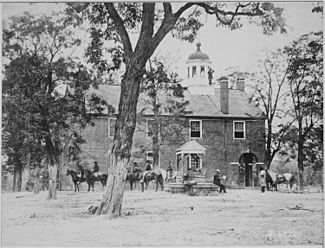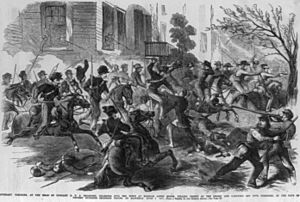Battle of Fairfax Court House (June 1861) facts for kids
Quick facts for kids Battle of Fairfax Court House |
|||||||
|---|---|---|---|---|---|---|---|
| Part of the American Civil War | |||||||
 Fairfax Court House, Virginia by Matthew Brady From U.S. National Archives |
|||||||
|
|||||||
| Belligerents | |||||||
| Commanders and leaders | |||||||
| Irvin McDowell David Hunter Charles Henry Tompkins |
Milledge Luke Bonham Richard S. Ewell (WIA) John Quincy Marr † William "Extra Billy" Smith |
||||||
| Strength | |||||||
| Between 50 and 86 | Between 40 and 80 engaged | ||||||
| Casualties and losses | |||||||
| 1 killed 4 wounded 3 captured |
1 killed 2 wounded 5 captured |
||||||
The Battle of Fairfax Court House was the first land battle of the American Civil War where soldiers died. It happened on June 1, 1861. A scouting group from the Union army met a local militia group in Fairfax, Virginia. This fight led to the first deaths in action and the first injury to a high-ranking officer.
The Union sent a cavalry patrol, led by Lieutenant Charles H. Tompkins. Their goal was to find out how many enemy soldiers were in the area. At Fairfax Court House, they surprised a small Confederate rifle company. This company was led by Captain John Q. Marr. The Union soldiers captured some prisoners.
Captain Marr quickly gathered his unit, but he was killed. A civilian, former Virginia governor William Smith, then took command. He managed to make the Union soldiers retreat. The battle ended without a clear winner. The Union didn't get the information they needed. This delay allowed the Confederates to gather more strength at Manassas. This happened before the much larger battle there the next month.
Contents
Why the Battle Happened
The American Civil War began when Confederate forces attacked Fort Sumter in April 1861. After this, President Abraham Lincoln asked for volunteers to join the Union army. He wanted to get back federal property and stop the rebellion. Four Southern states, including Virginia, refused to send troops. They decided to leave the Union and join the Confederacy.
Virginia officially left the Union on May 23, 1861. On May 31, about 210 Virginia soldiers, who would soon be Confederates, took over Fairfax Court House. This town was about 13.5 miles (21.7 km) west of Washington, D.C. The group included cavalry (soldiers on horseback) and infantry (soldiers on foot).
Lieutenant Colonel Richard S. Ewell was in charge of these soldiers. They were mostly untrained and didn't have much equipment. They were positioned there to help hide the growing Confederate forces at Manassas Junction. This was a key railroad spot about 10 miles (16 km) south.
On the same day, Union General David Hunter told Lieutenant Charles Henry Tompkins to find out about the Confederate forces. Hunter's orders about entering Fairfax Court House were not very clear. But he seemed to want Tompkins to go into the town for information. Around 10:30 p.m. on May 31, Tompkins led 50 to 86 Union cavalrymen. They rode from Falls Church, Virginia towards Fairfax Court House.
The Fight at Fairfax Court House
Around 3:00 a.m. on June 1, it was very dark. One of the Confederate guards, Private A. B. Francis, ran into Fairfax Court House. He shouted that the enemy was attacking. The other guard had been captured. Some Confederate cavalry tried to get ready to fight in the street. Others ran to get their horses.
As the Union soldiers arrived, most of the Confederate cavalry ran away. Four of them were left in the street and captured. Captain Marr moved his infantrymen into a field near a church. Some of his men accidentally shot their own cavalrymen in the dark. Other Confederate cavalrymen had no weapons or ammunition, so they also fled.
Captain Marr was killed during the fight. He was the first Confederate soldier to die in combat during the war. Historians believe he was hit by a random shot from the Union cavalry. His company was left without a leader.
The Union soldiers rode through the town, firing shots. Lieutenant Colonel Ewell, the Confederate commander, was shot in the shoulder. He was the first Confederate officer of his rank to be wounded in the war.
After Captain Marr fell, former Virginia governor William "Extra Billy" Smith stepped up. He was 64 years old and a civilian. But he knew many of the men and took charge. Ewell soon arrived, and Smith helped the men trust Ewell as their commander. Ewell then positioned about 40 men of the Warrenton Rifles.
As the Union soldiers rode back through town, the Confederates fired at them. This forced the Union soldiers to turn back. The Virginians were not in a good spot to defend themselves. So, Smith moved them to a better position behind some fences. Civilians also joined in the shooting from inside buildings. This might have made the Union soldiers think there were more Confederates than there actually were.
The Union soldiers tried to come back through town again. But the Warrenton men forced them to retreat with more gunfire. Lieutenant Tompkins had two horses shot from under him. One fell on him and hurt his foot. The Union cavalry had to leave town through fields. They took a longer way back to their base.
The Confederates reported one dead (Captain Marr) and two wounded (including Lt. Col. Ewell). They also said five of their men were captured. The Union side reported one killed, four wounded (including Lt. Tompkins), and three captured.
What Happened Next
After the battle, Confederate leaders were unhappy about their soldiers' lack of weapons. Union General Winfield Scott was also upset with Lieutenant Tompkins. Scott felt Tompkins had gone beyond his orders to just scout the area. Tompkins also talked to newspaper reporters before giving his official report.
At first, both sides exaggerated the number of enemy soldiers and how many they had wounded. Since the war had just started, this small battle got a lot of attention. Even though bigger battles with more deaths happened later, Fairfax Court House was important. It was the first time a Confederate soldier died in combat. It was also the first time a high-ranking officer was wounded.
In 1893, Charles Henry Tompkins received the Medal of Honor for his bravery at Fairfax Court House. This was the first time a Union Army officer received this award for actions in the Civil War. He got it 32 years after the battle. His award citation says he "Twice charged through the enemy's lines and, taking a carbine from an enlisted man, shot the enemy's captain." However, other reports don't say Tompkins himself shot Captain Marr.
A monument to Captain Marr was put up on June 1, 1904, near the courthouse. It says he was the "first soldier killed in action" in the war.
Weeks later, on July 17, Union forces took over Fairfax Court House. They were moving towards Manassas Junction for a bigger battle. The Confederates had left the town. Fairfax Court House saw several other small fights and raids during the war.
Images for kids
See also
 In Spanish: Batalla de Fairfax Court House (junio de 1861) para niños
In Spanish: Batalla de Fairfax Court House (junio de 1861) para niños




